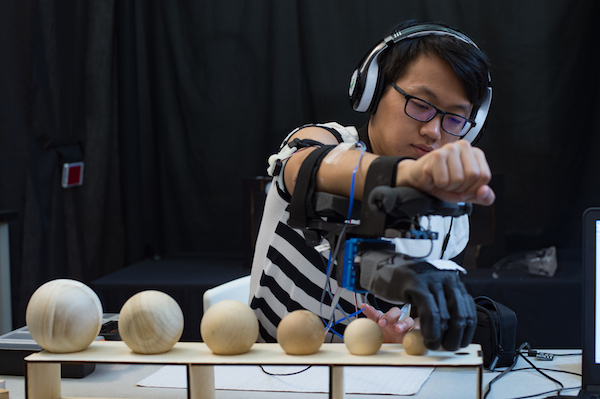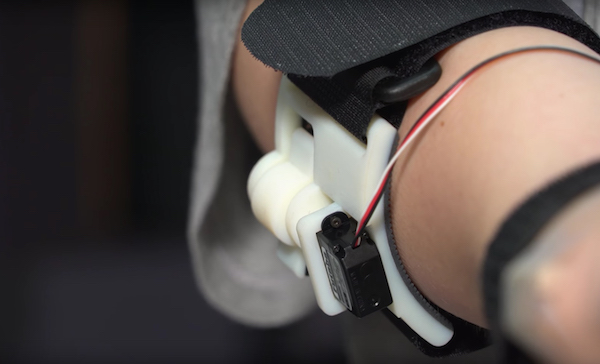
[Image above] Test subjects were more than twice as likely to correctly discern the size of objects grasped with a prosthetic hand when they received haptic feedback from a simple skin-stretch device on the upper arm. Credit: Jeff Fitlow/Rice University
Ever since the Egyptians created the first prosthetic limb—a big toe—the field of prosthetics had seen very little demand—until the American Civil War. A large number of casualties involving loss of limbs increased demand for prosthetic devices.
During World War I, the American Orthotics and Prosthetics Association was formed to promote research in the development of prosthetics. And veterans who returned home from World War II without limbs complained about the availability of prosthetic devices, prompting the government to devote funds toward prosthetic research.
According to the Amputee Coalition, nearly 2 million people are currently living with limb loss in the U.S. Doctors perform nearly 185,000 amputations each year.
Many prosthetic devices don’t address the day-to-day needs of many users. But more importantly, what’s missing in prosthetics today is the ability of users to sense what their limbs are doing without looking at them—a term called “muscle sense,” or proprioception.
In a collaboration with the Research Center “E.Piaggio” of the University of Pisa and the Italian Institute of Technology (IIT), engineers at Rice University are working to provide that missing muscle sense in prosthetic devices. Led by professor of mechanical engineering and computer science Marcia O’Malley, her team developed a prosthetic apparatus that provides sensory feedback—called haptics—in addition to the device’s regular functionality.
Their device—called the Rice Haptic Rocker—is a sensor that sits on the skin of the upper arm and connects to the SoftHand, a prosthetic hand developed by Pisa/IIT. When the hand closes, the Rice Haptic Rocker stretches the user’s skin—enabling the user to feel how open or closed the hand is.
“We’re using the tactile sensation on the skin as a replacement for information the brain would normally get from the muscles about hand position,” Janelle Clark, Rice graduate student and one of the research team members says in a press release. “We’re essentially mapping feedback from one source onto an aspect of the prosthetic hand. In this case, it’s how much the hand is open or closed.”

The Rice Haptic Rocker uses a rotating arm to brush a soft rubber pad over the skin of the arm. The more a prosthetic hand closes, the more the pad brushes the skin. Credit: Brandon Martin/Rice University
Pisa/IIT’s SoftHand is designed to act more like a human hand, based on their research of synergy control of the hand. Pisan graduate student Edoardo Battaglia worked with Clark in O’Malley’s lab to test their SoftHand with the Rice Haptic Rocker.
“People that use prosthetic hands would like to be able to feel with their hands like if they were their own—like we do with our hands,” Battaglia says in the video (below). “We are working on integrating this haptic device that is able to tell you how open and closed the hand is, so you can feel the movement on your arm.”
In one of the tests, subjects who were blindfolded were asked to grasp two different objects with the SoftHand and identify which was the larger of the two. Without the Rice Haptic Rocker attached, subjects chose the correct answer only one–third of the time. When they used the SoftHand with the Rice Haptic Rocker in the same test, subjects were able to correctly identify the larger object more than 70 percent of the time.
O’Malley says her team collaborates closely with doctors, physical therapists, and the end users. They actually involve end users all the way through the process—from the design and concept stage, to testing and evaluation. They will soon test the device with actual amputees.
“What’s really rewarding is to be able to bring them in at the end and not just see the scientific results of the experiments, but see their emotional reaction to having these capabilities and being able to work with the technology,” she says in the video.
The paper, submitted at the IEEE World Haptics 2017 conference is “The Rice Haptic Rocker: Skin Stretch Haptic Feedback with the Pisa/IIT SoftHand.”
Watch the video below to learn more.
